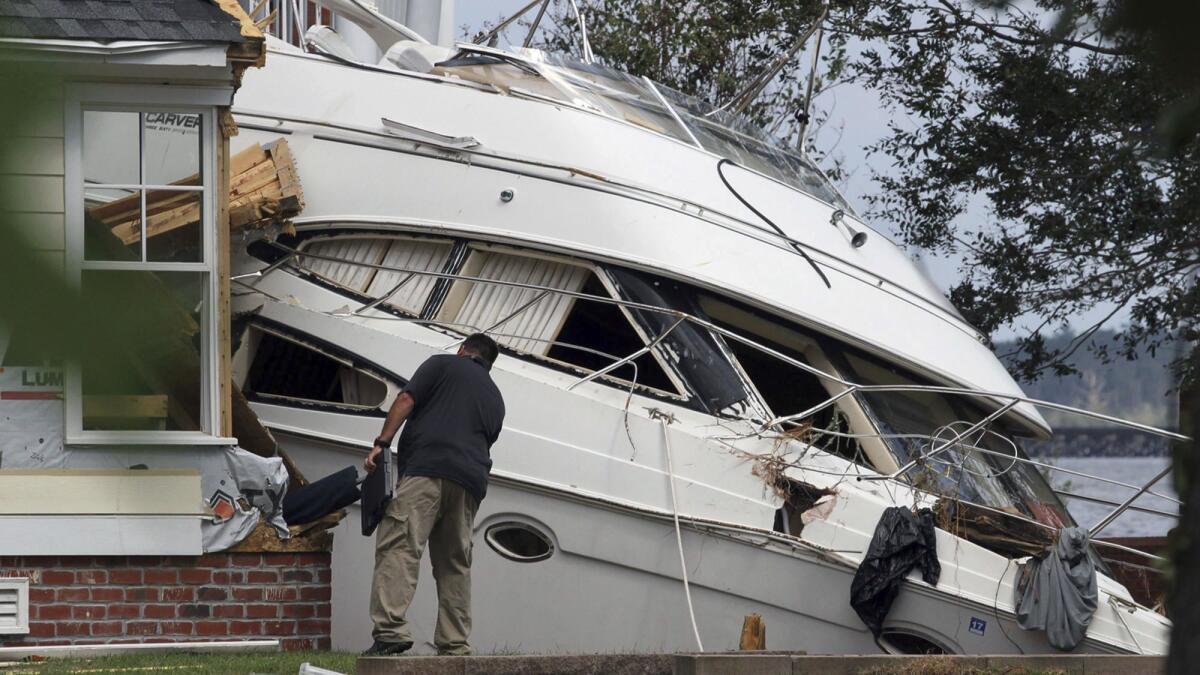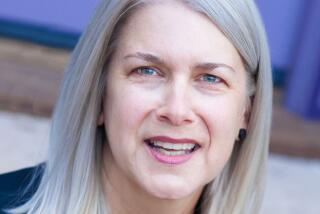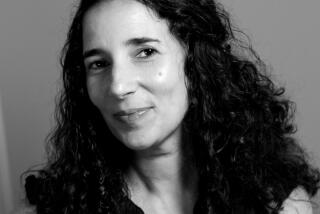Op-Ed: After living through Florence, I think few people realize how unstable the ground is beneath our feet

Last year, nine months after Hurricane Irma tore through the Caribbean, I traveled from my home in North Carolina to Anguilla to teach writing workshops to children and adults as part of a literary festival. As a prompt, I asked them to describe what they could not forget about the storm. When they read their work aloud, a large man wiped away tears as he described throwing his weight against his front door in a failed attempt to keep it closed. As she described the sound of the wind, a woman’s shoulders shook, and the person beside her laid a hand on her back to steady her. A student from a wealthier, more elevated neighborhood expressed guilt for how little she had suffered and lost. Children invented new ways to describe terror: The storm sounded like a pack of hungry wolves, or dinosaurs on the doorstep.
Each day in Anguilla I drove past a large stone church — Ebenezer Methodist. Built by enslaved Africans in 1830, it was the oldest house of worship on the island. Now its roof was completely gone, its ceiling the open sky. It was easier for me to envision wolves and dinosaurs than to imagine Irma’s 185 mph winds.
I was also stunned by the gratitude people expressed for unexpected gifts that came out of the storm. At night they saw fires burning across the ocean in St. Maarten, where armed forces had moved in to stop the looting and violence.
It doesn’t take much to reveal how fragile our supply chain has become and how easily our food and water sources can be disrupted.
Even though their island was without power for months, Anguillians experienced nothing like that. Instead people came together. No power meant more human connection. One man told me he got to know his son as they played dominoes by candlelight night after night. He thought his son would become a mechanic, but in the dark his son shared his dream of becoming a therapist. I had no idea, he said. Now that we have power and Wi-Fi again, he added, we’re back to facing our screens instead of each other.
I would like to say I learned a lot on that trip — but as soon as I returned home to a flurry of text and email messages, I forgot about most of it. I never imagined that less than a year later, my friends in Anguilla would reach out to express concern for me as Hurricane Florence gained strength off the coast of North Carolina.
In Chapel Hill where I live, two hours inland, my white friends and I weren’t talking about the storm yet, despite the media frenzy. Maybe we’d grown accustomed to seeing disasters unfold on screen and to other people — those who were poor and far away, whose skin was a different color, who did not look or sound like us. Or maybe we’d seen too many terrifying headlines, each announcing variations on the same theme: We are doomed.
But when friends in Anguilla messaged me to share what they knew about disaster preparation or to tell me they loved me, I became uneasy. They knew better than anyone what a storm like this could do.
Two days before Florence hit, I went to the grocery store for supplies — and found the shelves already almost empty. A woman pushed past me in the parking lot, her cart overflowing with the last available cases of water, avoiding eye contact with those left empty-handed. It doesn’t take much to reveal how fragile our supply chain has become and how easily our food and water sources can be disrupted. And when that happens, relationships become our most valuable resource. Individualism could be our undoing.
On the second day of the downpour, as the wind picked up and the sky darkened, I put on my rain jacket and went to my garden. Warm gusts bent the zinnia bushes sideways, revealing the jet-black centers of brilliant pink, yellow and orange blooms. As I snipped the stems, my foot sank into mud all the way up to my calf. How could the hard earth suddenly have become so yielding?
The water rose over the next three days and I compulsively checked the headlines. I watched my backyard turn into a pond. When the creek below my home burst its banks, I hiked down to take pictures. Scrolling through social media, I found pictures of locals smiling for selfies even as the water rose on the street behind them. Perhaps all those models and weather charts and live updates about the storm lulled us into feeling in control.
Enter the Fray: First takes on the news of the minute from L.A. Times Opinion »
Needing to feel less alone, I invited neighbors to dinner. Tired and restless, we let silence seep into the conversation. We watched their toddler son clamber up the arm of my couch, perch there precariously while shrieking with joy, and dive onto my lap again and again. To be together was the nourishment we needed.
Now the storm has passed and the sun has broken through the clouds. Sections of our town flooded — the walking trail beside the creek, the public pool — but the damage was minimal. Our relief is tinged with guilt, because while we were spared, not far from us houses are underwater — and the worst may be yet to come. So far, 42 are counted dead. The first photos of victims were African American faces, but local reporters did not consider race to be part of the story.
In my cul de sac, meanwhile, the crisis that captivated us is over. Life is back to normal — which is to say that the same challenges hang over us, quiet and pervasive as cloud cover: the escalating impact of climate change. The persistence of racial injustice. Rampant individualism. The assault of unbridled capitalism on family and community. And our seeming inability to grasp that the ground beneath our feet is nowhere near as solid as it seems.
Krista Bremer is the author of the memoir “A Tender Struggle” and associate publisher at the Sun.
Follow the Opinion section on Twitter @latimesopinionand Facebook
More to Read
A cure for the common opinion
Get thought-provoking perspectives with our weekly newsletter.
You may occasionally receive promotional content from the Los Angeles Times.






